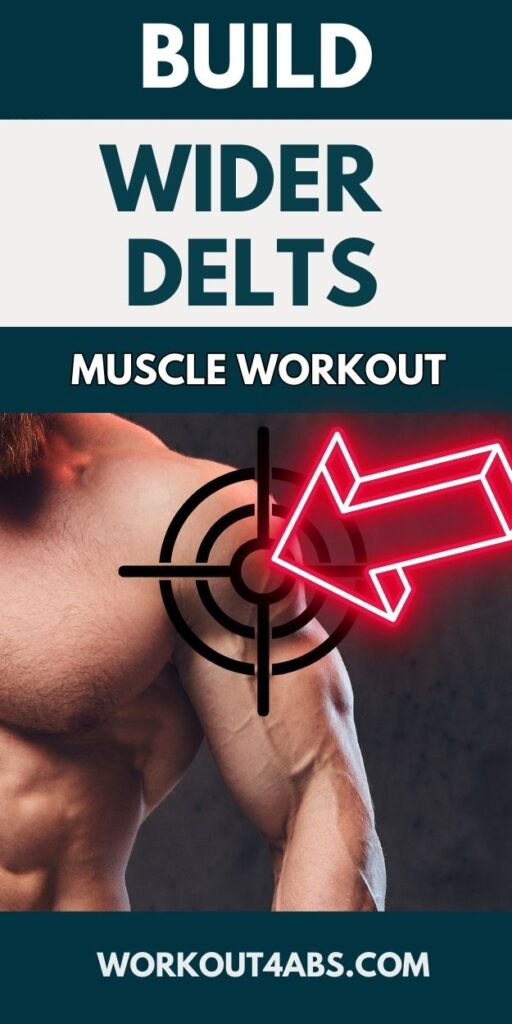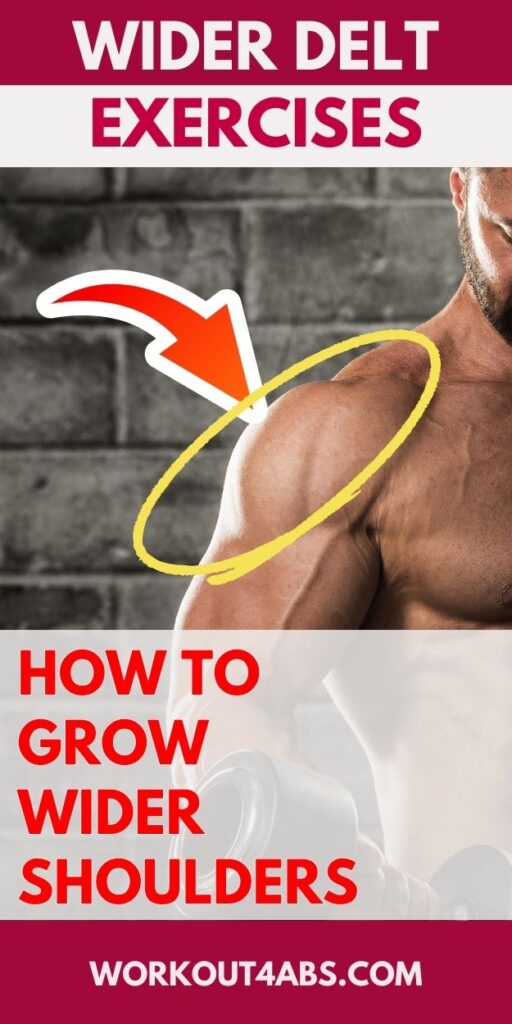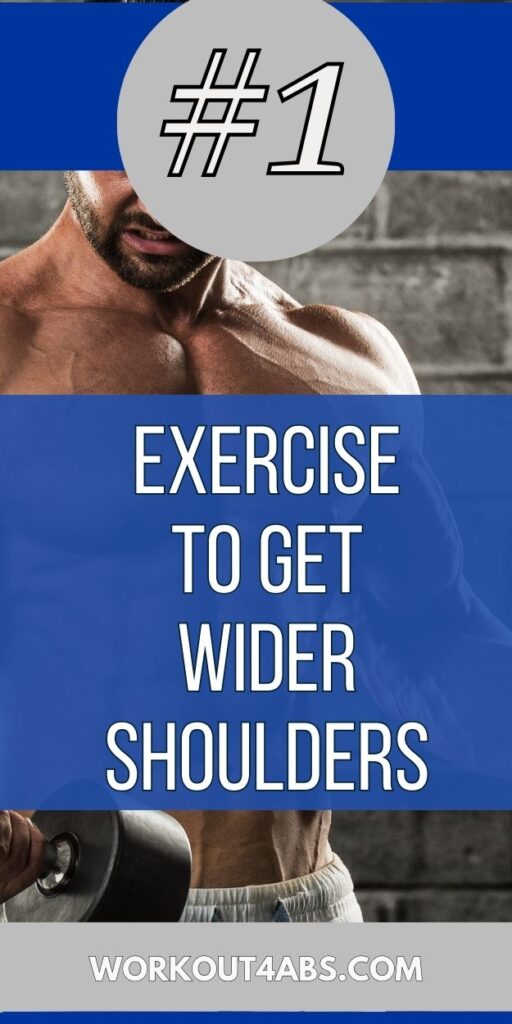Are you looking for a wider shoulder workout to sculpt broader, more powerful shoulders? Look no further. This article unveils a comprehensive shoulder workout regimen designed to help you build muscle size and achieve that coveted V-taper physique. Discover the targeted exercises and techniques to widen your shoulders, enhancing both strength and aesthetics.
This 100% Gets You WIDER!
If you enjoyed these tips, please save this pin to your Pinterest Board.

Dumbbell Lateral Raise with a Pronated Palm (Incline Bench)
Performing a dumbbell lateral raise with a pronated palm (thumb facing downward) and internal shoulder rotation targets the lateral head of the deltoid, contributing to the development of wider shoulders. Here’s how these factors play a role in building wider shoulders and why performing the exercise from an incline position can be advantageous:
- Pronated Palm and Internal Shoulder Rotation:
- When you pronate your palm and internally rotate your shoulder during a lateral raise, you change the angle at which the dumbbell moves away from your body. This adjustment shifts the focus of the exercise towards the lateral head of the deltoid, which is responsible for the rounded, wider appearance of the shoulder.
- Targeting the Lateral Deltoid:
- The lateral head of the deltoid is primarily responsible for the side deltoid development, contributing significantly to the overall width of the shoulder. By internally rotating your shoulder and pronating your palm, you engage this specific part of the deltoid more effectively.
- Creating Wider Shoulders:
- Over time, consistent training of the lateral head of the deltoid using this technique can lead to muscle hypertrophy (increased muscle size) in the lateral deltoid. As this muscle grows, it adds width to your shoulders, creating a broader and more aesthetically pleasing upper body appearance.
- Incline Position Advantage:
- Performing lateral raises from an incline bench position provides several benefits. In this setup, you sit on an incline bench with your chest against the bench pad, and your arms hang freely to perform the raises.
- Advantages of the incline position:
- Reduced cheating: It minimizes the use of momentum, helping you maintain strict form and isolate the lateral deltoid.
- Increased range of motion: The incline position allows your arms to move through a greater range of motion, effectively working the lateral deltoid from a stretched position at the bottom to a fully contracted position at the top.
- Enhanced muscle engagement: The incline angle places the lateral deltoid under tension throughout the exercise, intensifying the workout for better muscle development.
Incorporating dumbbell lateral raises with a pronated palm and internal shoulder rotation, especially when performed from an incline bench position, can be an effective way to target the lateral deltoid and build wider shoulders over time. Remember to start with an appropriate weight, maintain proper form, and progressively increase the resistance as you gain strength and develop your shoulder muscles.
If you enjoyed these tips, please save this pin to your Pinterest Board.

Side Lateral Raise in Scapular Plane
Side lateral raises performed in the scapular plane are an excellent exercise for targeting the deltoid muscles while minimizing the activation of the trapezius (traps). Here’s how this exercise achieves effective deltoid activation with limited trap involvement:
- Scapular Plane: The scapular plane is a term used to describe the natural, anatomical alignment of the shoulder joint. When you perform side lateral raises in this plane, your arms move slightly forward at a 30-45 degree angle from the front of your body. This aligns the movement with the orientation of your shoulder joint, reducing the risk of impingement and unnecessary stress on the shoulder.
- Deltoid Emphasis: Side lateral raises primarily target the deltoid muscles, specifically the lateral (side) head of the deltoid. This exercise isolates the lateral deltoid because the movement is in the direction where this muscle is most active. As you raise your arms to the side, the lateral deltoid is responsible for lifting the weight against gravity, leading to effective activation.
- Minimized Trap Activation: By keeping the movement within the scapular plane and avoiding excessive shrugging or elevation of the shoulders, you minimize the involvement of the trapezius muscles. The traps are responsible for elevating and retracting the shoulder blades, which can be reduced by maintaining proper form during side lateral raises.
- Controlled Range of Motion: A controlled range of motion is essential in this exercise. Raising the dumbbells too high or excessively shrugging the shoulders can lead to trap activation. Focus on lifting the weights until your arms are parallel to the ground, maintaining a slight bend in your elbows to avoid strain on the joints.
- Mind-Muscle Connection: To enhance the effectiveness of side lateral raises and minimize trap activation, concentrate on the sensation in your deltoid muscles during the movement. This mind-muscle connection can help you ensure that you’re targeting the intended muscle group.
In summary, side lateral raises in the scapular plane are an excellent exercise for isolating and activating the deltoid muscles, particularly the lateral deltoid, while minimizing trap involvement. This exercise, when performed with proper form and control, contributes to well-rounded shoulder development and can be an essential component of a shoulder-focused workout routine.
Band Stretch for Tight Internal Rotators
Equipment Needed:
- A resistance band or exercise band.
Instructions:
- Setup:
- Lie down on your back on a flat surface, such as a yoga mat or the floor.
- Have the resistance band nearby and ready for use.
- Positioning:
- Begin by extending your right arm out to the side, so it’s perpendicular to your body.
- Bend your right elbow at a 90-degree angle, creating an L-shape with your arm. Your forearm should be pointing upward.
- Band Attachment:
- Hold one end of the resistance band in your right hand. The other end of the band should be anchored securely to a fixed point, such as a heavy piece of furniture or a sturdy post, at roughly shoulder height.
- Stretching Action:
- Use your left hand to gently assist your right hand and forearm into internal rotation. This means you’re trying to bring your right hand closer to the floor while keeping your elbow at a 90-degree angle.
- Go only as far as you can comfortably without causing pain or discomfort. You should feel a stretch in your right shoulder.
- Release and Eccentric Load:
- Once you’ve reached a comfortable stretch, carefully let go of your right hand with your left hand.
- Your right hand will start to move downward due to the tension in the resistance band. This eccentric movement places an eccentric load on the internal rotators of the shoulder.
- Working Hand:
- As your right hand starts to move downward, use your right hand to resist the pull of the band and control the eccentric movement. The goal is to slow down the descent of your right hand.
- Hold and Repeat:
- Hold the stretched position for 20-30 seconds, focusing on deep and relaxed breathing.
- You can repeat the stretch 2-3 times, gradually increasing the range of motion as your shoulder muscles relax and adapt.
Tips:
- Start with a light resistance band and progress to a heavier band as your flexibility improves.
- Maintain a relaxed and comfortable position throughout the stretch.
- Perform this stretch slowly and with control, avoiding sudden or jerky movements.
- If you experience any pain or discomfort, stop immediately and consult with a healthcare professional.
This lying floor stretch with a resistance band is an effective way to work on shoulder mobility and flexibility, especially if you have tight internal rotators in the shoulder or if you’re recovering from a shoulder injury. It’s important to approach this stretch with care and to stay within a pain-free range of motion.
If you enjoyed these tips, please save this pin to your Pinterest Board.

Home › Aesthetic Body Plan ›Wider Shoulder Workout